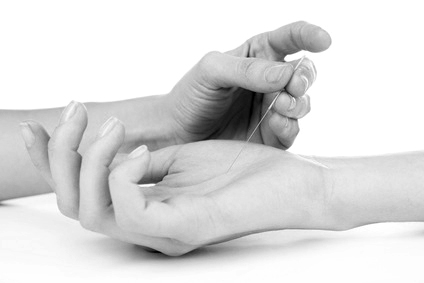The other in ourselves
Empathy: why do we feel for others?
Empathy has long been a riddle to philosophers. Now neuroscientists and psychologists search for an answer. They carry out sophisticated experiments that show how and why we empathise – or why we don’t.

Do you really know what I think and feel? Scientist can measure „empathic accuracy“.
A married couple in their 30s is sitting in a psychology laboratory. They have responded to a newspaper advertisement, and agreed to discuss an issue that is critical for their relationship in front of the camera. „Do we still love each other?“ is the topic that they have chosen to discuss. The couple is one of nearly a hundred couples who are taking part in a psychological experiment designed by the empathy researcher William Ickes, from the University of Texas at Arlington. It is not what they talk about that interests him. Dr. Ickes is more interested in how well one can sense the unspoken thoughts and feelings of others, and has been carrying out research in this area of social psychology since the 1980s. And so after the discussion, he put each partner in a separate room and asked them to tell him honestly what they really felt and thought in this situation.
The next step was for each subject to guess the thoughts and feelings of their partner, while watching the video recording and going through it step by step. „He’s really sexy,“ „She’s a bit crazy“, „When can we get this over with?“ were some of the feelings that were guessed. The research team then compared each subject’s actual feelings with the guesses of their partner, and worked out a success rate. Dr. Ickes refers to this as the empathic accuracy.
Regulating empathy
If you don’t know a person, your judgement is only likely to be accurate in 5 percent of cases, according to the researcher. However, accuracy jumps up to 20 percent after the first meeting, and then stays at 20 to 35 percent for close friends and partners. One point that emerges very clearly from this study and others by Dr. Ickes and his colleagues is this: the accuracy with which we assess other people’s feelings is not a fixed characteristic like eye colour. Our empathic ability depends very much on the situation and our motivation.
This was confirmed by the above experiment with spouses, which Ickes and his colleagues published earlier this year. For example, the results also showed that a person’s bonding style affects his ability to empathise. Participants who felt safely and firmly bonded reduced their empathy for their own protection if a difficult relationship issue was discussed. According to Dr. Ickes, this is a reasonable mechanism that helps to stabilise the relationship. However, people who did not feel safely bonded remained very empathic, even with sensitive topics – and jeopardised their peace of mind as well as their relationship. Dr. Ickes thinks that with a relationship, empathy is like money. One needs to have enough, but more empathy does not necessarily improve the relationship – it may even make it worse.
William Ickes deals with an aspect of empathy that researchers describe as cognitive empathy. In order to understand the feelings and thoughts of someone else, I have to put myself in his place. This takes well-developed conceptual or ‚cognitive‘ ability. This contrasts with emotional empathy, which is regarded as a more immediate form of empathy. This means that we feel for and with the other person. We feel his pain and flinch if he’s hurt, or we start to yawn if the other person yawns.
But whether cognition and emotion can really be separated in this area is increasingly doubtful. In fact there are studies which show that even physical empathy reactions that are apparently spontaneous may be influenced by higher mental processes. For example, prejudicial judgements can reduce empathic flinching of an observer’s hand if he sees someone else being pricked with a needle. So is empathy a matter of cognition, emotion or behaviour? „I think empathy involves everything,“ says Mark Davis, a psychologist who teaches at Eckerd College in Florida. In 1980 he developed the interpersonal reactivity index, a questionnaire that he designed to measure empathy. The respondent is asked about the extent to which he agrees with statements such as: „I often feel very touched by things that happen around me.“
Neural resonance
When social psychologists began to study empathy towards the end of the 1970s, they never dreamed that their interest would soon be shared with neurobiologists. „One of the biggest surprises of my career was when I suddenly received mail from brain researchers who wanted to know how to use my interpersonal reactivity index,“ Dr. Davis said. One reason that researchers had become interested in how mechanisms in the brain affected empathy was a discovery made in 1990. Giacomo Rizzolatti and his team at the University of Parma found nerve cells in the brains of macaques that were activated not only when the monkey performed a movement, but also when it saw this movement performed by another monkey or human. Further research led to the concept of mirror neurones. According this concept, the activity of certain nerve cells and neural circuits in the brain reflects the actions and feelings of other individuals. Last year, American researchers reported the existence of individual mirror neurones in humans for the first time. They demonstrated this by measuring the activity of individual nerve cells in epilepsy patients who had to undergo a surgical operation for their illness.
Fascinated by these discoveries, Christian Keysers joined Giacomo Rizzolatti’s team eleven years ago. Dr. Keysers is now 38 and leads the Social Brain Lab in Amsterdam. He and his colleague, the 42-year-old psychologist Tania Singer at the Max Planck Institute in Leipzig, represent a new generation of empathy researchers. They are not discouraged by the complexity of the topic and are prepared to tackle difficult problems – and they do so with a combination of psychology and neuroscience.
In 2004, Dr. Singer published a study in the prestigious journal „Science“ that is a landmark for neuropsychological research on empathy. Her question was: do we perceive other people’s pain in the same way as our own? Singer’s team measured the brain activity of women whose husbands were subjected to a painful stimulus, using functional magnetic resonance imaging (fMRI). They found that the areas of the brain that were activated in these women were the same as if they had received the pain stimulus themselves. The higher the empathy score of the men’s wives on the empathy scale developed by Dr. Davis, the greater the activity of the brain areas responsible for pain empathy.
Further studies showed that this neural resonance is not limited to partners, but also occurs with strangers. Moreover, not only are another person’s actions and pain reflected in the brain of an observer, but also their touch sensations and feelings. „I think that this is one of the most exciting discoveries of the last few years,“ says Keysers. It as if there were an invisible connection between our brains. He refers to this phenomenon as „shared circuits“.
Inhibitory prejudices
Studies carried out by both psychologists and neuroscientists have shown that we adjust our empathy level to our situation and the people around us. For example, Dr. Singer discovered that the empathic activity of one’s brain is reduced if we perceive other people as unfair, or if they are regarded as belonging to a competing group.
Last year, Grit Hein of the University of Zurich and Tania Singer tested football fans who watched as a member of their own club or a member of a rival club was given a slight electric shock. If an observer was willing to tolerate a lower intensity of the shock himself, he could reduce the pain of his counterpart. The conflict between impulses was reflected by the brain activity measured with fMRI. If the anterior insular cortex was active, observers were prepared to endure the pain of their counterparts themselves. However, if the reward centre was activated, they preferred to see their counterparts suffer. The latter was more often the case if the subject was a fan of the rival club. However, it is not just group membership that determines the extent of our empathy; recent results show that unconscious prejudices that we hold against others also play a role. For example, Allessio Avenanti showed that empathic physical reactions are stronger if the people we observe have the same skin colour as we do than if their skin colour is different. However, this was only the case if there were social prejudices against another skin colour.
Empathic psychopaths
One advantage of neural measurements of empathy is that one no longer has to rely solely on what we are told by the experimental subject. Any kind of self-reporting has limitations when it comes to how we would like to be perceived, according to Dr. Davis. We would probably all prefer to be seen as more empathetic than we really are. This even seems to apply to criminals. In his book „The Empathic Brain“, Dr. Keysers reports on an ongoing fMRI study at his institute. The question he asks is „Are psychopaths totally devoid of empathy? The initial results show a significantly lower empathic resonance in criminals with a psychopathic personality disorder. However, if they were asked to make a conscious effort to put themselves in another person’s shoes, the researchers no longer found any difference in brain activity between criminals and a control group. It seems as though criminals are capable of empathy, but they don’t necessarily use it.
How much empathy do we have? And to what extent can it be regulated? Even in people whose empathy is very limited, as is the case with autistic individuals, an understanding of emotions can be learnt to some extent. „Empathy is a resource that people don’t use enough,“ according to the British psychologist Simon Baron-Cohen in his recently published book, „Zero Degrees of Empathy“. He argues the case for specific empathy training. Tania Singer recently designed an experiment to see how this might work in practice. Subjects were trained in the Buddhist meditation technique known as „Metta“. The meditators were asked to develop friendly feelings towards themselves, their friends and their enemies. When they were tested a few days later, the training group did in fact show significantly more empathy than an untrained control group. In Dr. Singer’s view, if empathy training could be established as part of everyday life in institutions, it could have a significant social impact.




